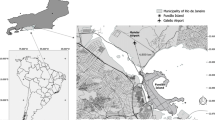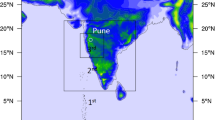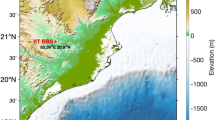Abstract
Estimating critical weather conditions for the generation of storms with heavy rainfall represents one of the main challenges in the scientific community, especially in the warm season. While the use of radiosonde data is a possible option, an important limitation for achieving reliable forecasting of extreme rainfall events is undoubtedly low spatio-temporal resolution. As such, this research work endeavored to provide a special contribution by analyzing radiosonde data specifically collected for such evaluation applied to a tropical area, namely the city of Rio de Janeiro, Brazil. In that context, we applied a method recommended by previously reviewed literature consisting of replacing air temperature of a sounding probe launched in the morning (12 UTC) with forecasted values using data observed in the afternoon in order to gauge the method. Data points measured by radiosondes launched in the afternoon (between 12 and 7 pm local time) were used to evaluate the proposed method. The results showed that the atmosphere presented the highest heating rates in the atmospheric layer closest to the surface during the afternoon for diurnal clouds (DC) days. Similar behaviour was observed for the days of the South Atlantic Convergence Zone (SACZ). For days with frontal system (FS) presence, however, lower temperature values were observed in the afternoon in relation to the measured by morning soundings. Winds presented northeast and southwest components leading to the occurrence of warm and cold advection, respectively, in the analyzed region. Thermodynamic variables tended to be overestimated in relation to observed field results in most of the analyzed days.









Similar content being viewed by others
References
Acevedo OC, Degrazia GA, Puhales FS, Martins LGN, Oliveira PES, Teichrieb C, Silva SM, Maroneze R, Bodmann B, Mortarini L, Cava D, Anfossi D (2017) Monitoring the micrometeorology of a coastal site next to athermal power plant from the surface to 140 m. Bull. Am Meteorol Soc. https://doi.org/10.1175/BAMS-D-17-0134.1
Andrade KM (2005) Climatologia e comportamento dos sistemas frontais sobre a América do Sul. Dissertation, National Institute for Space Research
Arya SP (2001) Introduction to micrometeorology, 2nd edn. Elsevier, New York
Azevedo LHDR (2009) Avaliação de método de previsão para tempestades convectivas severas por mudança da temperatura do ar e do ponto de orvalho junto à superfície em sondagens atmosféricas. Monography, Federal University of Rio de Janeiro
Balling RC, Cerveny RS (2003G) Vertical dimensions of seasonal trends in the diurnal temperature range across the central United States. Geophys Res Lett 25:25. https://doi.org/10.1029/2003GL017776
Barros AP, Kim G, Williams E, Nesbitt SW (2004) Probing orographic controls in the Himalayas during the monsoon using satellite imagery. Nat Hazard Earth Syst 4(1):29–51
Blanchard DO (1998) Mesoscale convective patterns of the southern high plains. Bull Am Meteor Soc 71:994–1005
Bluestein HB (1993) Synoptic-dynamic meteorology in midlatitudes. Volume II: observations and theory of weather systems. New York, USA
Boers N, Bookhagen B, Marwan N, Kurths J (2015) Spatiotemporal characteristics and synchronization of extreme rainfall in South America with focus on the Andes Mountain range. Clim Dyn 46:601–617. https://doi.org/10.1007/s00382-015-2601-6
Brooks HE (2006) A global view of severe thunderstorms: Estimating the current distribution and possible future changes In: Preprints, Severe Local Storms Special Symposium, American Meteorological Society, Atlanta
Coleman RF, Drake JF, McAtee MD, Belsma LO (2010) Anthropogenic moisture effects on WRF summertime surface temperature and mixing ratio forecast skill in Southern California. Weather Forecast 25:1522–1535
Das S, Ashrit R, Iyengar GR, Mohandas S, Gupta MD, George JP, Rajagopal E, Dutta SK (2008) Skills of different mesoscale models over Indian region during monsoon season: Forecast errors. J Earth Syst Sci 117:603–620
Davolio S, Mastrangelo D, Miglietta MM, Drofa O, Buzzi A, Malguzzi P (2009) High resolution simulations of a flash flood near Venice. Nat Hazards Earth Syst Sci 9:1671–1678
Dereczynski CP, Oliveira JSD, Machado CO (2009) Climatologia da precipitação no município do Rio de Janeiro. Rev Bras Meteorol 24(1):24–38. https://doi.org/10.1590/s0102-77862009000100003
Derubertis D (2006) Recent trends in four common stability indices derived from US radiosonde observations. J Clim 19:309–323
Doswell CA, Haugland MJ (2007) A comparison of two cold fronts—effects of the planetary boundary layer on the mesoscale. Electronic Journal of Severe Storms Meteorology. https://www.ejssm.org/ojs/index.php/ejssm/article/viewarticle/30/24. Acessed 02 March 2018
Doswell CA III (1987) The distinction between large-scale and mesoscale contribution to severe convection: a case study example. Weather Forecast 2:3–16
Dourado MS, Oliveira AP (2001) Observational description of the atmospheric and oceanic boundary layers over the Atlantic Ocean. Braz J Oceanogr. 49:49–59
Fawbush EJ, Miller RC (1953) A method of forecasting hailstone size at the earth’s surface. Am Meteorol Soc 34:235–244
Ferreira NJ, Correia AA, Ramirez MCV (2004) Synoptic scale features of the tropospheric circulation over tropical South America during the WETAMC TRMM/LBA experiment. Atmosfera 17(1):13–30
Figueroa SN, Bonatti JP, Kubota PY, Grell GA, Morrison H, Barros SRM, Fernandez JPR, Ramirez E, Siqueira L, Luzia G, Silva J, Silva JR, Pendaharkar J, Capistrano VB, Alvim DS, Enoré DP, Diniz FLR, Satyamurty P, Cavalcanti IFA, Nobre P, Barbosa HMJ, Mendes CL, Panetta J (2016) The Brazilian global atmospheric model (BAM): performance for tropical rainfall forecasting and sensitivity to convective scheme and horizontal resolution. Weather Forecast 31:1547–1572
Foss M (2011) Condições atmosféricas conducentes à ocorrência de tempestades convectivas severas na América do Sul. Dissertation, Federal University of Santa Maria
Galway J (1956) The lifted index as a predictor of latent instability. Bull Am Meteorol Soc 37:528–529
Gensini VA, Mote TL, Brooks HE (2014) Severe thunderstorm reanalysis environments and collocated radiosonde observations. J Appl Meteorol Climatol 53:742–751. https://doi.org/10.1175/JAMC-D-13-0263.1
Gottlieb RJ (2009) Analysis of stability indices for severe thunderstorms in the northeastern United States. Dissertation, Cornell University
Gulizia C, Camilloni I (2014) Comparative analysis of the ability of a set of CMIP3 and CMIP5 global climate models to represent precipitation in South America. Int J Climatol 35:583–595
Haklander AJ, Van Delden A (2003) Thunderstorm predictors and theirforecast skill for the Netherlands. Atmos Res 67–68:273–299
Hart RE, Forbes GS, Grum RH (1998) The use of hourly model-generated soundings to forecast mesoscale phenomena. Part I: Initial assessment in forecasting warm-season phenomena. Weather Forecasting 13:1165–1185. https://doi.org/10.1175/1520-0434(1998)013,1165:FTTUOH.2.0.CO;2
Holton JR, Pyle J, Curry JA (2002) Encyclopedia of Atmospheric Sciences. Academic Editor, New York,
Huntrieser H, Schiesser H, Schmid W, Waldvogel A (1996) Comparasion of tradicional and newly developed thunderstorm indices for Switzerland. Weather Forecast 12:108–125
Jacovides CP, Yonetani T (1990) An evaluation of stability indices for thunderstorm prediction in Greater Cyprus. Weather Forecast 5:559–569
Jewell R, Brimelow J (2009) Evaluation of Alberta hail growth model using severe hail proximity soundings from the United States. Weather Forecasting 24:1592–1609
Jones C, Carvalho LMV (2013) Climate change in the South American monsoon system: Present climate and CMIP5 projections. J Clim 26:6660–6678
Kirkpatrick C, McCaul EW, Cohen C (2009) Variability of updraft and downdraft characteristics in a large parameter space study of diurnal convection Mon Weather Rev 10.1175/2008MWR2703.1
Kottayil A, Buehler SA, John VO, Miloshevich LM, Milz M, Holl G (2001) On the importance of Vaisala RS92 radiosonde humidity corrections for a better agreement between measured and modeled satellite radiances. Atmos Ocean Technol. https://doi.org/10.1175/JTECH-D-11-00080.1
Kunz M (2007) The skill of convective parameters and indices to predict isolated and severe thunderstorms. Nat Hazards Earth Syst Sci 7:327–342
Li L, Gochis DJ, Sobolowski S, Mesquita MD (2017) Evaluating the present annual water budget of a Himalayan headwater river basin using a high-resolution atmosphere-hydrology model. J Geophys Res Atmos 122:4786–4807
Lopez P (2007) Cloud and precipitation parameterizations in modeling and variational data assimilation: a review. J Atmos Sci 64:3766–3784
Manzato A (2008) A Verification of Numerical Model Forecasts for Sounding-Derived Indices above Udine. NE Italy. Weather Forecasting 23(3):477–495
Manzato A, Morgan G Jr (2003) Evaluating the sounding instability with the lifted parcel theory. Atmos Res 67–68:455–473
Marinaki A, Spiliotopoulos M, Michalopoulou H (2006) Evaluation of atmospheric instability indices in Greece. Adv Geosc 7:131–135
Markowski PM, Straka JM, Rasmussen EN (2002) Direct surface thermodynamic observations within the rear-flank downdrafts of nontornadic and tornadic supercells. Mon Weather Rev 130:1692–1721
Mattioli V, Westwater ER, Cimini D, Liljegren JC, Lesh BM, Gutman SI, Schmidlin FJ (2007) Analysis of radiosonde and ground-based remotely sensed PWV data from the 2004 North Slope of Alaska Arctic Winter Radiometric Experiment. J Atmos Ocean Technol. https://doi.org/10.1175/JTECH1982.1
McCaul EW Jr, Cohen C (2002) The impact on simulated storm structure and intensity of variations in the mixed layer and moist layer depths. Mon Weather Rev 130:1722–1748
Miglietta MM, Manzato A, Rotunno C (2016) Characteristics and Predictability of a Supercell during HyMeX SOP1: Characteristics and Predictability of a Supercell during HyMeX SOP1. Q J R Meteorol Soc 142:2839–2853
Miller RC (1972) Notes on analysis and severe storm forecasting procedures of the Air Force GlobalWeather Center, AWS Tech. Report 200 (Rev.), Headquarters Air Weather Service, Scott AFB, pp 106
JTS Moore, M Nolan, FH Glass, DL Ferry, SM Rochette (1995) Flash flood-producing high-precipitation supercells in Missouri. Preprints. In: 14th Conference on weather analysis and forecasting, Dallas, TX American Meteorological Society (J4), pp 7–12
Nallapareddy A, Shapiro A, Gourley JJ (2011) A Climatology of nocturnal warming events associated with cold-frontal passages in Oklahoma. J Appl Meteorol Clim 50:2042–2061. https://doi.org/10.1175/JAMC-D-11-020.1
Nascimento EL (2005) Previsão de tempestades severas utilizando-se parâmetros convectivos e modelos de mesoescala: uma estratégia operacional adotável no Brasil? Rev Bras Meteor 20(1):113–122
Ninomiya K (2007) Similarity and difference between the South Atlantic convergence zone and the Baiu frontal zone simulated by an AGCM. J. Meteorology Soc 85:277–299
Oakley NS, Lancaster JT, Kaplan ML, Ralph FM (2017) Synoptic conditions associated with cool season post-fire debris flows in the Transverse Ranges of southern California. Nat Hazards. https://doi.org/10.1007/s11069-017-2867-6
Onderlinde MJ, Fuelberg HE (2014) A parameter for forecasting tornadoes associated with landfalling tropical cyclones. Weather Forecasting 29:1238–1255
Pardo SK (2009) High-resolution analysis of the initiation of deep convection forced by boundary-layer processes. Dissertation, Karlsruhe University
Púcik T, Groenemeijer P, Rýva D, Kolár M (2015) Proximity soundings of severe and nonsevere thunderstorms in central Europe. Mon Weather Rev. 143:4805–4821. https://doi.org/10.1175/MWR-D-15-0104.1
Quadro MFL, Silva Dias MAFd, Herdies DL, Gonçalves LGG (2012) Análise climatológica da precipitação e do transporte de umidade na região da ZCAS através da nova geração de reanálises. Rev Bras Meteorol 27(2):152–162
Ratnam MV, Santhi YD, Rajeevan M, Rao SVB (2013) Diurnal variability of stability indices observed using radiosonde observations over a tropical station: comparison with microwave radiometer measurements. Atmos Res 124:21–33
Reid GC, Gage KS (1891) On the annual variation in height of the tropical tropopause. J Atmos Sci. 38:1928–1938
Revathy K, Prabhakaran Nayar SR, Krishna Murthy BV (2001) Diurnal variation of tropospheric temperature at a tropical station. Ann. Geophys. 19:1001–1005
Roe GH, Montgomery DR, Hallet B (2003) Orographic precipitation and the relief of mountain ranges. J Geophys Res Solid Earth. https://doi.org/10.1029/2001JB001521
Satyamurti P, Rao VB (1988) Zona de Convergência do Atlântico Sul. Climanálise 3:31–35
Schumacher R, Johnson RH (2005) Organization and environmental properties of extreme-rain-producing mesoscale convective systems. Mon Wea Rev 133:961–976
Schumacher RS, Peters JM (2017) Near-surface thermodynamic sensitivities in simulated extreme-rain-producing mesoscale convective systems. Mon Weather Rev 145:2177–2200. https://doi.org/10.1175/MWR-D-16-0255.1
Seidel DJ, Free M, Wang J (2005) Diurnal cycle of upper-air temperature estimated from radiosondes. J Geophys Res. https://doi.org/10.1029/2004JD005526
Seluchi ME (2009) Chou ESC (2009) Synoptic patterns associated with landslide events in the Serra do Mar Brazil. Theor Appl Clim. 98:67–77
Sherwood SC (2000) Climate signal mapping and an application to atmospheric tides. Geophys Res Lett 27:3525–3528
Silva FP, Justi da Silva MGA, Menezes WF, Almeida VA (2016) Avaliação de indicadores atmosféricos utilizando o modelo numérico WRF em eventos de chuva na cidade do Rio de Janeiro. https://doi.org/10.11137/2015_2_81_90
Silva FP, Justi-da-Silva MGA, Rotunno Filho OC, Pires GD, Sampaio RJ, Magalhães AAA (2018) Synoptic thermodynamic and dynamic patterns associated with Quitandinha River flooding events in Petropolis, Rio de Janeiro (Brazil) Meteorol Atmos Phys 25:25 doi: 10.1007/s00703-018-0609-2.
Silva FP, Rotunno Filho OC, Sampaio RJ, Dragaud ICV, Magalhães AAA, Justi da Silva MGA, Pires GD (2017) Evaluation of atmospheric thermodynamics and dynamics during heavy-rainfall and no-rainfall events in the metropolitan area of Rio de Janeiro. Brazil Meteorol Atmos Phys. https://doi.org/10.1007/s00703-017-0570-5
Silva Dias MAF (1987) Sistemas de mesoescala e previsão de tempo a curto prazo. Rev Bras Meteorol 2:133–150
Silva Dias MAF (2000) Índices de instabilidade para previsão de chuva e tempestades severas. Departamento de Ciências Atmosféricas. https://www.redemet.aer.mil.br/uploads/2014/04/indice_sweat.pdf. Acessed date 02 March 2018
Silvestro F, Rebora N, Cummings G, Ferraris L (2015) Experiences of dealing with flash floods using an ensemble hydrological nowcasting chain: implications of communication, accessibility and distribution of the results J Flood Risk Manag doi:10.1111/jfr3.1216 (in press)
Tajbakhsh S, Ghafarian P, Sahraian F (2012) Instability indices and forecasting thunderstorms: the case of 30 April 2009. Nat Hazards Earth Syst Sci 12:1–11. https://doi.org/10.5194/nhess-12-403-2012
Teixeira MS, Satyamurty P (2007) Dynamical and synoptic characteristics of heavy rainfall episodes in southern Brazil. Mon. Weather Rev. 135:598–617
Trier SB, Davis CA, Ahijevych DA (2010) Environmental controls on the simulated diurnal cycle of warm-season precipitation in the continental United States. J Atmos Sci 67:1066–1090. https://doi.org/10.1175/2009JAS3247.1
Tuttle JD, Davis CA (2006) Corridors of warm season precipitation in the central United States. Mon Weather Rev. 134:2297–2317. https://doi.org/10.1175/MWR3188.1
Wagner TH, Feltz WF, Ackerman SA (2008W) The Temporal evolution of convective indices in storm-producing environments. Weather Forecast 23:786–794. https://doi.org/10.1175/2008WAF2007046.1
Weisman M, Klemp JB (1982) The dependence of numerically-simulated diurnal convection on vertical wind shear and buoyancy. Mon Weather Rev 110:504–520
Weisman ML, Klepm JB (1986) Caracteristics of Isolated Diurnal convection. Ray PS Mesoscale Meteorology and Forecasting. American Meteorological Society, Boston, pp 331–358
Westwater ER, Boba Stankov B, Cimini D, Han Y, Joseph A, Lesht BM, Long CN (2003) Radiosonde humidity soundings and microwave radiometers during Nauru99. J Atmos Ocean Technol. 20:953–971
Wetzel SW, Martin JE (2001) An Operational Parameters – Based Methodology For Forecasting Midlatitude Winter Season Precipitation. Weather Forecast 16:156–167
Wilde NP, Stull RB, Eloranta EW (1985) The LCL zone and cumulus onset. J. Clim Appl Meteorol 24:640–657. https://doi.org/10.1175/1520-0450(1985)024,0640:TLZACO.2.0.CO;2
WMO (2018) World Meteorological Organization. https://library.wmo.int/opac/doc_num.php?explnum_id=3795. Acessed 02 March 2018
Wyszogrodzki AA, Liu Y, Jacobs N, Childs P, Zhang Y, Roux G, Warner TT (2013) Analysis of the surface temperature and wind forecast errors of the NCAR-AirDat operational CONUS 4-km WRF forecasting system. Meteorol Atmos. Phys. 122:125–143
Acknowledgements
The authors would like to thank the Civil Engineering Program of the Alberto Luiz Coimbra Institute of Postgraduate Studies and Research in Engineering (COPPE)—part of the Universidade Federal do Rio de Janeiro (UFRJ)—for their support, particularly offered through the Laboratory of Water Resources and Environmental Studies (LABH2O), as well as the Meteorology and Atmospheric Physics editorial board for their revisions. The authors would also like to recognize the support of the Coordenação de Aperfeiçoamento de Pessoal de Nível Superior (CAPES), which helped fund this work through CAPES Call 27/2013—Pró-Equipamentos Institucional and CAPES/MEC Call No. 03/2015—BRICS; we further thank the Conselho Nacional de Desenvolvimento Científico e Tecnológico (CNPq), which helped fund this work through CNPq Universal Call for Papers No. 14/2013—Proceeding No. 485136/2013-9 and CNPq Call No. 12/2016—Proceeding No. 306944/2016-2; the National Secretariat of Higher Education (SESu)—part of the Ministry of Education (MEC) (2010–2016) (PET CIVIL UFRJ); the Fundação de Amparo à Pesquisa do Estado do Rio de Janeiro (FAPERJ), which helped fund this work through Project FAPERJ—Pensa RiovCall 34/2014 (2014–2018)—E-26/010.002980/2014, FAPERJ No. E_12/2015 and FAPERJ nº E-22/2016; as well as the Brazilian Ministry of Science and Technology (MCT), through its Financier of Studies and Projects (FINEP) and in particular its CT-HIDRO Fund (2005–2016), which is focused on researching rainfall–runoff and atmospheric modeling, water and energy balances, and extreme flood and drought events. This study was financed in part by the Coordenação de Aperfeiçoamento de Pessoal de Nível Superior- Brasil (CAPES)—Finance Code 001.
Author information
Authors and Affiliations
Corresponding author
Additional information
Responsible Editor: M. Telisman Prtenjak.
Publisher's Note
Springer Nature remains neutral with regard to jurisdictional claims in published maps and institutional affiliations.
Electronic supplementary material
Below is the link to the electronic supplementary material.



Rights and permissions
About this article
Cite this article
da Silva, F.P., Rotunno Filho, O.C., Justi da Silva, M.G.A. et al. Observed and estimated atmospheric thermodynamic instability using radiosonde observations over the city of Rio de Janeiro, Brazil. Meteorol Atmos Phys 132, 297–314 (2020). https://doi.org/10.1007/s00703-019-00688-3
Received:
Accepted:
Published:
Issue Date:
DOI: https://doi.org/10.1007/s00703-019-00688-3




